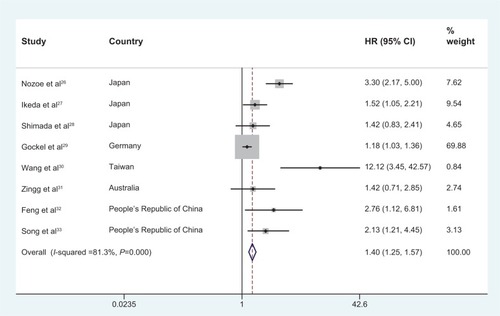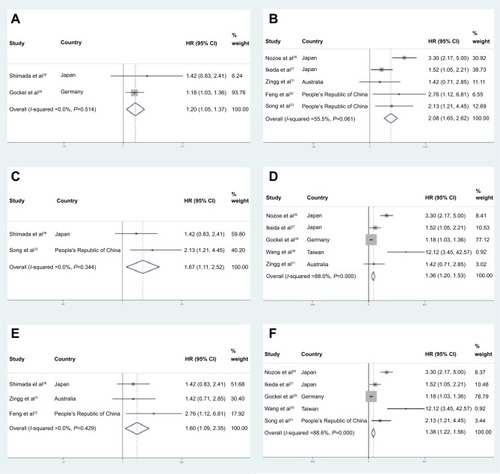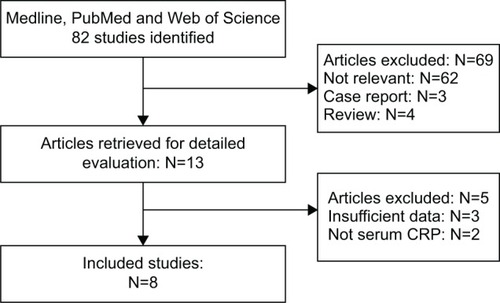Abstract
Background
Recent studies have shown that C-reactive protein (CRP) is a useful predictive factor in several cancers; however, its role in esophageal cancer (EC) is controversial.
Methods
A systematic literature search was performed using Medline, PubMed, and Web of Science to analyze the prognostic value of serum CRP in patients with EC. A meta-analysis was performed to assess the association between serum CRP and overall survival (OS) in patients with EC.
Results
A total of eight studies involving 1,471 patients were included in our study. Our pooled results demonstrated that a high level of serum CRP was associated with poor OS (hazard ratio [HR]: 1.40, 95% confidence interval [CI]: 1.25–1.57, I2=81.3%, P<0.0001). Subgroup analyses were performed in further investigations. When the patients were segregated according to treatment, pathological type, and cut-off level, high levels of serum CRP were found to be significantly correlated with OS.
Conclusion
Our meta-analysis revealed that high levels of serum CRP were significantly associated with poor OS in patients with EC.
Keywords:
Introduction
Esophageal cancer (EC) is the eighth most frequent cancer and the sixth leading cause of cancer death worldwide.Citation1 Surgical resection remains the modality of choice, however, the prognosis is poor.Citation2 The reason for this may be the relatively late stage of diagnosis and rapid progression.Citation3,Citation4 Thus, it is important for us to identify predictive factors for the prognosis in patients with EC.
In an attempt to better estimate the prognosis, many prognostic factors have been investigated, such as depth of invasion, nodal metastasis, tumor-node-metastasis (TNM) stage, and other miscellaneous factors.Citation5,Citation6 Recently, systemic inflammatory response (SIR) has been found to play an important role in cancer.Citation7,Citation8 Serum C-reactive protein (CRP) is a very sensitive indicator of SIR, and was initially identified in the plasma of patients as a substance reacting with pneumococcal C-polysaccharide, which appeared in patients with inflammation.Citation9–Citation11 CRP is synthesized mainly by hepatocytes as a part of the SIR.Citation12,Citation13 CRP is a representative acute-phase reactant and is the most widely used systemic biomarker of inflammation.Citation14,Citation15
Previously published studies have shown that serum CRP is a predictor of survival in several cancers, such as gastric cancer,Citation16,Citation17 colorectal cancer,Citation18,Citation19 pancreatic cancer,Citation20 hepatocellular cancer,Citation21 urological cancer,Citation22 ovarian cancer,Citation23 lymphoma,Citation24 and osteosarcoma.Citation25 Similar results have also been found in patients with EC.Citation26–Citation33 Nozoe et alCitation26 and Ikeda et alCitation27 demonstrated that CRP can be an independent marker in patients with EC. Gockel et alCitation29 investigated 291 EC patients who underwent curative resection, and they concluded that a high level of CRP is associated with tumor progression and poor overall survival (OS). This observation is in line with data from Wang et al,Citation30 Feng et alCitation32 and Song et alCitation33 but is contrary to the results of Shimada et alCitation28 and Zingg et alCitation31 who suggested that CRP is not an independent factor. Due to the inconsistent results, the role of serum CRP in EC is still controversial. In this study, therefore, we conduct a systematic review and meta-analysis to analyze the prognostic value of serum CRP for OS in patients with EC.
Materials and methods
Literature search
A systematic literature search was performed using Medline, PubMed, and Web of Science to analyze the prognostic value of CRP in patients with EC from 1984 to 2013. The search strategies included the keywords “C-reactive protein” or “CRP” combined with “esophageal cancer” or “esophageal carcinoma”. All selected studies were English language articles. Only human research was included. In addition, the reference lists of the identified studies were checked for further relevant studies.
Inclusion/exclusion criteria
Inclusion criteria for this meta-analysis were as follows: 1) patients were diagnosed as having EC by pathology; 2) the serum CRP was measured before treatment; 3) the relationship between CRP and OS was reported. The exclusion criteria were: 1) review, letter, case report, or nonhuman research; 2) insufficient data to extract the hazard ratio (HR) and the 95% confidence interval (CI).
Data extraction
Three authors (Huang, Feng, and Liu) reviewed the included studies and extracted the data independently. If the results reported overlapped, only the most recent or the most complete study was used in the meta-analysis. The extracted data included “authors”, “year”, “sample”, “country”, “treatment”, “pathological type”, “cut-off level”, “TNM stage”, and HR and 95% CI for the correlation between serum CRP and OS.
Statistical analysis
All statistical analyses were performed using Stata version 12.0 (StataCorp LP, College Station, TX, USA). The pooled HR and 95% CI were used to analyze the relationship between CRP and OS. A significant heterogeneity was defined as P<0.10 or I2>50%.Citation34 A combined HR>1 indicated a worse OS, and it was considered statistically significant if the 95% CI did not overlap.
Results
According to the search strategies described, a total of 82 studies were identified. The search results are shown in . After reviewing all 82 studies carefully, eight eligible studies, including 1,471 patients with EC, were included in the meta-analysis.Citation26–Citation33 The main characteristics of the eight included studies are listed in . Among these studies, three were performed in Japan,Citation26–Citation28 two in the People’s Republic of China,Citation32,Citation33 one in Germany,Citation29 one in Taiwan,Citation30 and one in Australia.Citation31 Five studies set a cut-off value of 5 mg/L,Citation26,Citation27,Citation29,Citation30,Citation33 and three studies set a cut-off value of 10 mg/L.Citation28,Citation31,Citation32
Table 1 Characteristics of included studies
Our pooled results demonstrated that high levels of serum CRP were associated with poor OS in patients with EC (HR: 1.40, 95% CI: 1.25–1.57). The analysis showed a significant heterogeneity for OS (I2=81.3%, P<0.0001) (). In further investigations, subgroup analyses were also performed in our meta-analysis. When the patients were segregated according to treatment, pathological type, and cut-off level, high levels of serum CRP were also found to be significantly correlated with OS (; ).
Figure 2 Forest plot of the association between serum CRP and OS in EC.

Figure 3 Forest plot of the association between serum CRP and OS in EC by subgroup analyses.
Abbreviations: CRP, C-reactive protein; OS, overall survival; EC, esophageal cancer; HR, hazard ratio; CI, confidence interval.

Table 2 Subgroup analyses of pooled HRs for increased serum CRP and OS in EC
Discussion
In this meta-analysis, our pooled results demonstrated that high levels of serum CRP were associated with poor OS in patients with EC (HR: 1.40, 95% CI: 1.25–1.57). There was a significant heterogeneity for OS (I2=81.3%, P<0.0001). We did further subgroup analyses to evaluate the correlation between serum CRP and OS in the included studies.
In the subgroup analyses, with data stratified by treatment and pathological type, both subgroups showed significant HRs and 95% CIs. These results, on the other hand, indicated that no matter what treatment or pathological type the patients were in, the high levels of serum CRP could significantly predict the poor OS in patients with EC. In addition, when stratified by cut-off value, the results were also significant no matter what cut-off level was used: 5 mg/L (HR: 1.38, 95% CI: 1.22–1.56, I2=88.6%) or 10 mg/L (HR: 1.60, 95% CI: 1.09–2.35, I2=0).
The molecular mechanism by which CRP can be correlated with a prognosis of cancer remains to be determined. One possible explanation is interleukin-6 (IL-6). CRP is synthesized mainly by hepatocytes.Citation12,Citation13 Production of CRP by hepatocytes is induced mainly by IL-6, although other cytokines, such as tumor necrosis factor α (TNFα), transforming growth factor β (TGFβ), and IL-1, can also synthesize this protein.Citation35,Citation36 It has been reported that IL-6 is able to contribute to the cancer growth and progression.Citation37,Citation38 Moreover, IL-6 probably links the inflammation and angiogenesis via the expression of vascular endothelial growth factor (VEGF).Citation39 On the other hand, as with other proteic biomarkers of SIR, CRP has several biological functions, including complement activation and platelet activation.Citation40,Citation41
There are several limitations in our meta-analysis. First, the number of included studies was limited. Second, significant heterogeneity was observed. Third, the pooled predictive HR between serum CRP and OS were not strong (HR=1.40, P<0.0001). Empirically, HR>2 is considered strongly predictive.Citation42 Therefore, the results should be used with caution when using CRP to predict OS in EC. Moreover, our meta-analysis showed that CRP is an independent predictive factor in patients with EC; however, it should be kept in mind that CRP alone, without other variables, may not be associated with postoperative survival in patients with EC. In addition, in our study, variation in the types of treatment may have had an influence on OS, and this can possibly introduce bias into the study. The results should therefore be interpreted with caution. Further large prospective studies should be performed to confirm whether serum CRP has a prognostic value in patients with EC.
In conclusion, our meta-analysis revealed that high levels of serum CRP were significantly associated with poor OS in patients with EC. We conclude that serum CRP might serve as a useful biomarker for EC.
Disclosure
The authors declare no conflicts of interest. The authors alone are responsible for the content and writing of the paper.
References
- SiegelRNaishadhamDJemalACancer statistics, 2013CA Cancer J Clin2013631113023335087
- EloubeidiMADesmondRArguedasMRReedCEWilcoxCMPrognostic factors for the survival of patients with esophageal carcinoma in the US: the importance of tumor length and lymph node statusCancer20029571434144312237911
- FengJFZhaoQChenQXPrognostic value of subcarinal lymph node metastasis in patients with esophageal squamous cell carcinomaAsian Pac J Cancer Prev20131453183318623803101
- TachibanaMKinugasaSHiraharaNYoshimuraHLymph node classification of esophageal squamous cell carcinoma and adenocarcinomaEur J Cardiothorac Surg200834242743118502142
- PeyreCGHagenJADeMeesterSRThe number of lymph nodes removed predicts survival in esophageal cancer: an international study on the impact of extent of surgical resectionAnn Surg2008248454955618936567
- FengJFHuangYZhaoQTumor length in elderly patients with esophageal squamous cell carcinoma: is it a prognostic factor?Ups J Med Sci2013118314515223617771
- BalkwillFMantovaniAInflammation and cancer: back to Virchow?Lancet2001357925553954511229684
- MantovaniAAllavenaPSicaABalkwillFCancer-related inflammationNature2008454720343644418650914
- TillettWSFrancisTJrSerological reactions in pneumonia with a nonprotein somatic fraction of pneumococcusJ Exp Med193052456158519869788
- DiehlEEHainesGKIIIRadosevichJAPotempaLAImmunohistochemical localization of modified C-reactive protein antigen in normal vascular tissueAm J Med Sci20003192798310698090
- PotempaLASiegelJNFiedelBAPotempaRTGewurzHExpression, detection, and assay of neoantigen (neo-CRP) associated with a free, human C-reactive subunitMol Immunol19872455315412443837
- EgenhoferCAlsdorffKFehselKKolb-BachofenVMembrane associated C-reactive protein on rat liver macrophages is synthesized within the macrophages, expressed as neo-C-reactive protein and bound through a C-reactive protein-specific membrane receptorHepatology1995185121612238225228
- WeinholdBRütherUInterleukin-6-dependent and independent regulation of the human C-reactive protein geneBiochem J19973274254299359411
- GabayCKushnerIAcute phase protein and other systemic responses to inflammationN Engl J Med199934064484549971870
- VolanakisJEHuman C-reactive protein: expression, structure, and functionMol Immunol2001382–318919711532280
- ShimuraTKitagawaMYamadaTC-reactive protein is a potential prognostic factor for metastatic gastric cancerAnticancer Res201232249149622287736
- NozoeTIguchiTAdachiEMatsukumaAEzakiTPreoperative elevation of serum C-reactive protein as an independent prognostic indicator for gastric cancerSurg Today201141451051321431483
- KoikeYMikiCOkugawaYPreoperative C-reactive protein as a prognostic and therapeutic marker for colorectal cancerJ Surg Oncol200898754054418937231
- NozoeTMatsumataTKitamuraMSugimachiKSignificance of preoperative elevation of serum C-reactive protein as an indicator for prognosis in colorectal cancerAm J Surg199817643353389817250
- PineJKFusaiKGYoungRSerum C-reactive protein concentration and the prognosis of ductal adenocarcinoma of the head of pancreasEur J Surg Oncol200935660561019128923
- HashimotoKIkedaYKorenagaDThe impact of preoperative serum C-reactive protein on the prognosis of patients with hepatocellular carcinomaCancer200510391856186415779015
- KarakiewiczPIHuttererGCTrinhQDC-reactive protein is an informative predictor of renal cell carcinoma-specific mortality: a European study of 313 patientsCancer200711061241124717639589
- HeflerLAConcinNHofstetterGSerum C-reactive protein as independent prognostic variable in patients with ovarian cancerClin Cancer Res200814371071418245530
- HerishanuYPerryCBraunsteinREarly-mid treatment C-reactive protein level is a prognostic factor in aggressive non-Hodgkin’s lymphomaEur J Haematol200779215015417635239
- Zahlten-HinguranageAGoldschmidtHCremerFWPreoperative elevation of serum C-reactive protein is predictive for prognosis in myeloma bone disease after surgeryBr J Cancer200695778278716969356
- NozoeTSaekiHSugimachiKSignificance of pre-operative elevation of serum C-reactive protein as an indicator of prognosisAm J Surg2001182219720111574097
- IkedaMNatsugoeSUenoSBabaMAikouTSignificant host- and tumor-related factors for predicting prognosis in patients with esophageal carcinomaAnn Surg2003238219720212894012
- ShimadaHNabeyaYOkazumiSElevation of pre-operative serum C-reactive protein level is related to poor prognosis in esophageal squamous cell carcinomaJ Surg Oncol200383424825212884238
- GockelIDirksenKMessowCMJungingerTSignificance of preoperative C-reactive protein as a parameter of the perioperative course and long-term prognosis in squamous cell carcinoma and adenocarcinoma of the oesophagusWorld J Gastroenterol200612233746375016773693
- WangCYHsiehMJChiuYCHigher serum C-reactive protein concentration and hypoalbuminemia are poor prognostic indicators in patients with esophageal cancer undergoing radiotherapyRadiother Oncol200992227027519195729
- ZinggUForbergerJRajcicBLangtonCJamiesonGAssociation of C-reactive protein levels and long-term survival after neoadjuvant therapy and esophagectomy for esophageal cancerJ Gastrointest Surg201014346246919937473
- FengJFZhaoHGLiuJSChenQXSignificance of preoperative C-reactive protein as a parameter in patients with small cell carcinoma of the esophagusOnco Targets Ther201361147115124009425
- SongZBLinBCLiBPreoperative elevation of serum C-reactive protein as an indicator of poor prognosis for early-stage esophageal squamous cell carcinomaKaohsiung J Med Sci2013291266266624296054
- HigginsJPTThompsonSGDeeksJJAltmanDGMeasuring inconsistency in meta-analysesBMJ2003327741455756012958120
- GresserIDelersFTran QuangsNTumor necrosis factor induces acute phase protein in ratsJ Biol Regul Homeost Agents1987141731762459907
- KutaAEBaumLLC-reactive protein is produced by a small number of normal human peripheral blood lymphocytesJ Exp Med198616413213263723078
- TakizawaHOhtoshiTOhtaKGrowth inhibition of human lung cancer cell lines by interleukin-6 in vitro: a possible role in tumor growth via an autocrine mechanismCancer Res19935318417541818364912
- NachbaurDMHeroldMManeschgAHuberHSerum levels of interleukin-6 in multiple myeloma and other hematological disorders: correlation with disease activity and other prognostic parametersAnn Hematol1991622–354582031968
- HuangSWuMWangHPYangCSKuoMLLinJTCorrelation between serum levels of interleukin-6 and vascular endothelial growth factor in gastric carcinomaJ Gastroenterol Hepatol200217111165116912453275
- AllinKHNordestgaardBGElevated C-reactive protein in the diagnosis prognosis, and cause of cancerCrit Rev Clin Lab Sci201148415517022035340
- GroblewskaMMroczkoBSosnowskaDSzmitkowskiMInterleukin-6 and C-reactive protein in esophageal cancerClin Chim Acta201241319–201583159022609487
- HayesDFIsaacsCStearnsVPrognostic factors in breast cancer: current and new predictors of metastasisJ Mammary Gland Biol Neoplasia20016437539212013528

